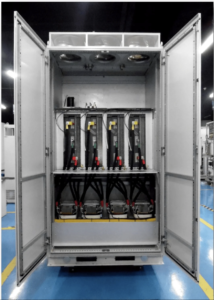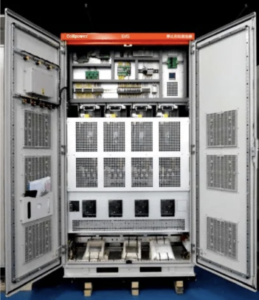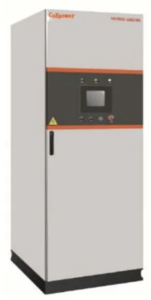Our products
DVR DYNAMIC VOLTAGE RESTORER



Introduction
A dynamic voltage restorer (DVR) is a power electronic device used to protect sensitive electrical equipment from voltage dips, swells and interruptions. DVRs detect voltage anomalies and inject the necessary voltage to maintain a stable and continuous supply, ensuring the integrity and reliability of the power delivered to critical loads.
Operating principle
DVRs are connected in series between the power supply and the protected load, it will continuously monitor the input side supply voltage. Once the supply voltage is found to deviate from the rated voltage level, the DVR will produce a suitable compensation voltage injection system by IGBT into the inverter system, ensuring the output side (i.e. load side) voltage is stable and the protected load is not affected by voltage changes.
Grid voltage within limits: When the grid supplies the load (in online mode), the inverter sleeps but remains synchronized with the grid voltage for immediate action in case of grid disturbance.

Voltage drop occurrence: When power occurs on the power grid, the double reverse switch will quickly turn off, thus isolating itself from the power grid, from the inverter to the load power supply.

Voltage re-stabilized: DVR turns on the double reverse switch, the inverter circuit is closed, the load will be supplied by the mains again, and the rectifier circuit recharges the energy storage capacitor.

Fail-safe bypass operation: In case of DVR failure or maintenance, the load current will be automatically transferred to the fail-safe bypass. That is, the current will be directly supplied to the load through the contactor or bypass switch connected in parallel to the thyristor.

Applications
- Industrial Plants
- Heavy Industries: Steel mills, aluminum smelters, chemical plants.
- Manufacturing: Semiconductor manufacturing, automobile production, textile factories.
- Benefits: Protects sensitive equipment, minimizes production downtime and ensures continuous operation.
- Commercial buildings
- Office Complexes: Maintains stable power supply for office equipment and computer networks.
- Shopping Centers: Ensures reliable operation of lighting, HVAC systems and electronic devices.
- Benefits: Prevents equipment malfunction, reduces energy consumption, improves energy quality.
- Renewable energy systems
- Wind Farms: Compensates for voltage drops caused by fluctuations in wind speed.
- Solar Power Plants: Stabilizes voltage variations caused by intermittent solar power generation.
- Benefits: Improves power quality, supports grid stability and reduces energy losses.
- Public services and energy distribution
- Substations: Provide voltage regulation and support during faults and disturbances.
- Distribution Networks: Ensures stable voltage levels for end consumers.
- Benefits: Improves grid reliability, reduces transmission losses and supports the integration of renewable energy.
- Data centers
- Server Rooms: Protect servers and data storage devices from power outages and interruptions.
- Network Operations Centers: Ensure reliable operation of network equipment.
- Benefits: Improves power quality, prevents data loss, and improves system uptime.
- Sanitary facilities
- Hospitals: Maintains power quality for critical medical equipment and systems.
- Diagnostic Laboratories: Protects sensitive diagnostic devices from voltage disturbances.
- Benefits: Ensures reliable operation of medical equipment, reduces energy costs and improves power quality.
Benefits
DVRs play a crucial role in maintaining power quality, protecting electrical equipment, and improving the overall efficiency and reliability of electrical systems in various applications and industries.
- Improved power quality
- Eliminates voltage drops, surges and interruptions.
- Ensures stable and continuous power supply for critical loads.
- Improved equipment lifespan
- Protects sensitive equipment from voltage-related damage.
- Reduces the risk of equipment failure and extends operational life.
- Increased system reliability
- Mitigates the risk of production downtime and process interruptions.
- Ensures the continuous and reliable operation of critical processes and systems.
- Energy saving
- Reduces energy losses associated with voltage disturbances.
- Improves overall electrical system efficiency, leading to lower energy costs.
- Compliance with Standards
- Ensures compliance with electrical quality standards and regulations.
- Avoid penalties and ensure compliance with industry standards.
- Scalability and flexibility
- Modular design allows for easy expansion and adaptation to changing power demands.
- Suitable for a wide range of applications from low voltage to high voltage systems.
- Support for the integration of renewable energies
- Stabilizes voltage levels for wind and solar power plants.
- Facilitates the integration of renewable energy sources into the grid.
- Environmental benefits
- Reduce energy waste and lower your carbon footprint.
- Promotes the use of clean and efficient energy technologies.
